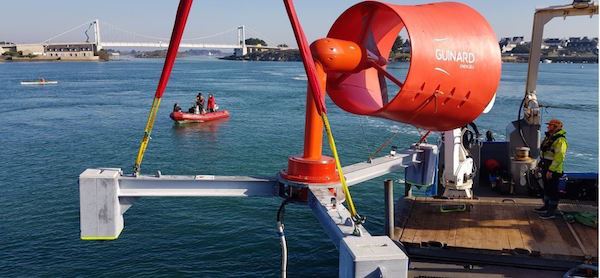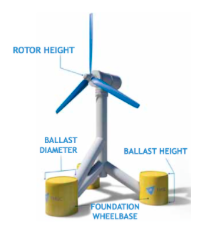
A gravity-based structure is a gravity foundation, widely used for offshore energy and oil platforms in shallow waters. Offshore wind turbines deliver a strong promise in today’s tough times of climate changes’ debates. The continuous development of the sector requires reliable and innovative concepts, contributing to the LCOE cost reductions.
The main component of gravity-based structures is the ballast. This is the element, responsible for the turbine’s stabilisation and therefore its success. The material of which the ballast has been made determines its efficiency and reliability, influencing elements such as volume, erosion, corrosion and many more.
Common Applications of Gravity-Based Foundations
As part of the Marine Renewable Energy the tidal technology is the one which mainly uses gravity-based foundations. Despite different technical issues and a medium level of maturity, tidal energy can be a really promising technology once coupled with other renewable energy sources to obtain a comprehensive energy mix.
Current projects with gravity-based foundations include Hydroquest, Meygen and Sabella.
Gravity-based foundations offers a stabilisation solution, highly appreciated for its easy installation in water depth of 20 to 80 meters, especially in challenging environment with tight operation windows, heavy currents and high waves. The only disadvantage of this solution is that the commonly applied concrete has too big volume, which induces the need for bigger vessels and heavier lifting means. The hydrodynamic loads applied during the installation and in operational conditions are also higher due to the most important contact area. Finally the use of concrete and low-density ballast causes an important footprint on the seabed.
The market is seeking for new and innovative solutions. Cast iron ballast has been recently tested from Sabella, Hydroquest and Guinard Energies and highly appreciated for its performance.

FMGC Gravity Base Ballast for the MegaWattBlue 20kW P154
Gravity-based foundations are used as well for the stabilisation of offshore wind farms and oil and gas platforms. However, these industries are also deploying other solutions depending on the site conditions and specific requirements.
When deployed by the oil and gas sector, GBS are usually constructed in fjords because of their protected area and sufficient depth. Prior to deployment, a study of the seabed should be conducted to ensure the stability of the foundation’s topside and its capacity to withstand the different loads during its lifecycle. In this case, professionals are rather seeking for high-quality solutions requiring less possible maintenance and having limited footprint on the seabed.
Gravity Base Ballast Made of Cast Iron – An Innovative Answer to A Common Problem

Gravity-based foundations reinforced with concrete or sand ballast require important seabed preparations as they are heavier and transfer the loads directly to the seabed surface. The site preparation triggers significant cost and are quite invasive. Moreover, concrete-made gravity-based foundations require a massive supporting structure, leading to the need for more material and logistic cost. The larger surface results as well in a larger footprint and higher chances of potential damage of the seabed.
Compared to concrete, cast iron is up to 3 times denser and therefore can deliver a much more compacter solution, allowing a significant volume and weight reduction. The research of FMGC, the European leader in the manufacture of cast iron counterweights, conducted by INNOSEA (the study is available only in French, for further questions, please contact FMGC), a Marine Engineering consultant company, has proven the volume reduction and the fact that it limits the hydrodynamic loads applied on the gravity base. The hydrodynamic loads reduction, coupled with the limited volume of the ballast results in a reduction of the needed weight, especially for sites with high currents where the reduction can reach from 3 to 7 times.
The objective of this research was to find a way to optimize the gravity base ballast for tidal turbines.
Other Possible Applications of Cast Iron Ballast
The cast iron ballast can be applied as well to other applications where a compact static ballast solution is required. Besides the gravity based platforms there are other elements that need to be securely stabilized as well.
In the harsh tidal and wave environments the stabilisation of the connector and junction boxes are of critical importance. To avoid any risk of damages and ensure a reliable grid connexion, once put on the seabed, these parts need to be kept reliably in a position. For cases like these, cast iron offers an easy installable and compact solution thanks to its high density and the possibility to get tailored to the project’s needs.
Cast iron gravity base ballast offers as well a cost-efficient solution for the optimization of a platform’s mooring. A mooring design with a suction pile needs to withstand considerable vertical loads on the anchors. To handle these loads, the suction piles have to be larger and bigger, inducing a high production cost. A coupled solution including the use of cast iron gravity ballast on the top of the suction pile can bear a part of the vertical loads, allowing the reduction of the dimensions of the suction piles.
And last but not least, the cast iron ballast can fit inside a floating platform as static ballast as well. A spar foundation such as the one used for Hywind Scotland for example features a steel weight of 2, 300 tons but a total weight of around 10,000 tons because of the amount of the ballast that has been used. Here a cast iron solution can represent a part of the ballast and thanks to its high density contribute to the reduction of the volume needed and the associated substructures.
The 25 years of experience and knowledge on the cast iron own by FMGC, coupled with an important understanding of the offshore environment and associated needs and requirements for the marine renewable environment guarantee excellent performance, reliability and safety. This solution proves that ingenious solutions with no impact on the environment are not necessarily the most expensive ones. Combining simple design with expertise should be the motors of innovation.
